|
 Tubulicrinis thermometrus Tubulicrinis thermometrus
SynonymsPeniophora thermometra
Tubulicrinis thermometrus
BiostatusPresent in region - Indigenous. Endemic
Images (click to enlarge)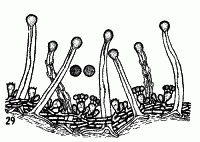
Caption: Fig. 29. Peniophora thermometra G.H.Cunn. Transverse section, x 500. Spores, x 1000. | 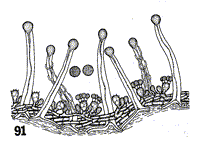
Caption: FIG. 91. Tubulicrinis thermometra. Showing the naked cystidia tapering to the
expanded apices, with lumena almost capillary save at apices, and globose spores.
Some cystidia are enmeshed in hyphal sheaths. | 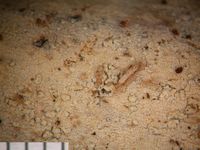
Owner: J.A. Cooper | 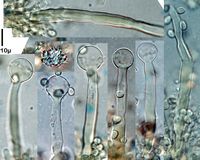
Owner: J.A. Cooper | 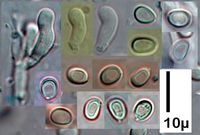
Owner: J.A. Cooper |
Article: Stalpers, J.A.; Buchanan, P.K. (1991). Type studies of the species of Pellicularia and Peniophora described by G.H. Cunningham. New Zealand Journal of Botany 29(3): 331-340 (http://www.rsnz.org/publish/abstracts.php).
Description: Lyocystidia radicate, tapering, with an inflated apex, 35-60 x 3.5-4.5 µm, apex 4.5-6 µm diam. Mature
basidia not seen. Spores globose to subglobose, 3.2-5 x 3.5-4.7 µm, not amyloid.
Notes: We concur with the descriptions of this species given by Cunningham (1955, 1963) and Weresub (1961).
The delicate hymenophore and substrate of the holotype make observation difficult; PDD 11483 is the
only New Zealand collection of T. thermometrus. The species differs from T. accedens (Bourdot &
Galzin) Donk by the (sub)globose spores and smaller cystidia.
Article: Cunningham, G.H. (1963). The Thelephoraceae of Australia and New Zealand. New Zealand Department of Scientific and Industrial Research, Bulletin 145: 359 p. Wellington:.
Description: Hymenophore a tenuous greyish film barely visible upon the substratum,
annual, arachnoid, adherent, to 5 x 2 cm; hymenial surface dingy white,
delicately pruinose, arachnoid; margin arachnoid, white, adherent. Context a
tenuous layer 10-18 µm thick, basal layer of a few repent hyphae, soon
collapsed, intermediate layer wanting; generative hyphae 2-2.5 µm diameter,
walls 0.2 µm thick, naked, with clamp connections. Cystidia arising in the base
of the context and projecting for the greater part of their length, cylindrical
or slightly attenuated towards the rounded and inflated apices, 45-64 x 4-6 µm,
bases forked, lumena capillary, save at apices where expanded and bulbous, walls
naked or as often enmeshed in delicate hyphal sheaths. Hymenial layer composed
of scattered basidia, paraphyses, and cystidia. Basidia clavate, 6-8 x 4-5 µm,
bearing 4 spores; sterigmata arcuate, to 4 µm long. Paraphyses clavate, 4-6 x
3-4 µm. Spores globose, apiculate, 3.5-4 µm diameter, walls smooth, hyaline, 0.2
µm thick.
Habitat: HABITAT: Effused on decayed decorticated fallen trunks.
Distribution: DISTRIBUTION: New Zealand.
Notes: Cystidia project for
almost their entire length, and are cylindrical or slightly tapering with
inflated apices; walls, save at apices, are so thickened that lumena are
capillary, and are destroyed with aqueous solutions of potassium hydroxide. They
become enmeshed in hyphal sheaths. Apices are thin-walled and inflated so that
cystidia, like those of T. gracillima, resemble miniature inverted
thermometers. Basidia are small, clavate, and develop directly from hyphae of
the basal layer. Fructifications appear as delicate white or greyish arachnoid
films upon the surface of fallen decayed trunks; visible to the eye when fresh,
in the herbarium fructifications can be seen only with the aid of a dissecting
microscope. The species resembles T. accedens (B. & G.) Donk in
shape of the cystidia, but differs in the smaller basidia, globose spores and
more delicate fructifications.
Article: Cunningham, G.H. (1955). Thelephoraceae of New Zealand. Part VI. The genus Peniophora. Transactions of the Royal Society of New Zealand 83(2): 247-293.
Description: Hymenophore a tenuous greyish film barely visible upon the substratum, annual, arachnoid,
adnate, to 5 x 2 cm, surface clingy white, delicately pruinose, arachnoid; margin arachnoid,
white, adnate. Context a tenuous layer 10-18 µ thick, basal layer of a few repent hyphae, soon
collapsed, intermediate layer absent; generative hyphae 2-2.5 µ diameter, walls 0.2 µ thick,
hyaline, naked, branched, septate, with clamp connexions. Hymenial layer composed of
scattered basidia, paraphyses and cystidia. Basidia arising directly from the basal layer,
clavate, 6-8 x 4-5 µ, 4-spored; sterigmata arcuate, 2-4 µ long. Paraphyses scanty, subclavate,
about half the size of the basidia. Cystidia arising in the base of the context and projecting for
the greater part of their length, cylindrical or slightly attenuated towards their apices, 45-64 x
4-6 µ, bases forked, apices rounded and inflated, lumen capillary, save at apex where
expanded and bulbous, walls naked or as often enmeshed in delicate hyphal sheaths. Spores
globose, apiculate, 3.5-4 µ diameter, walls smooth, hyaline, 0.2 µ thick.
Habitat: HABITAT. Effused on decayed decorticated logs.
Distribution: DISTRIBUTION. New Zealand.
Notes: This delicate species may be identified by the cystidia, small basidia, small globose spores
and absence of an intermediate layer. Cystidia project for almost their entire length and are
cylindrical with inflated apices; walls, save at the apices, are so thickened that the lumen is
capillary, and are destroyed with potassium hydroxide solutions. They become enmeshed in
hyphal sheaths. Apices are thin-walled and inflated, so that the cystidia, like those of P.
gracillima, resemble small inverted thermometers. Basidia are small, clavate, and develop
directly from hyphae of the basal layer. Fructifications appear as a delicate white or greyish
arachnoid film upon the surface of decayed logs; visible to the eye when fresh, in the
herbarium fertile portions can be seen only with the aid of a dissecting microscope.
The species resembles P. accedens Bourd. & Galz. in the shape of the cystidia, but differs in.
the smaller basidia, globose spores and more delicate fructifications.
Article: Cunningham, G.H. (1963). The Thelephoraceae of Australia and New Zealand. New Zealand Department of Scientific and Industrial Research, Bulletin 145: 359 p. Wellington:.
Description: Hymenophore a tenuous greyish film barely visible upon the substratum, annual,
arachnoid, adherent, to 5 x 2 cm; hymenial surface dingy white, delicately pruinose,
arachnoid; margin arachnoid, white, adherent. Context a tenuous layer 10-18 µ, thick,
basal layer of a few repent hyphae, soon collapsed, intermediate layer wanting; generative
hyphae 2-2.5 µ diameter, walls 0.2 µ thick, naked, with clamp connections. Cystidia
arising in the base of the context and projecting for the greater part of their length,
cylindrical or slightly attenuated towards the rounded and inflated apices, 45-64 x 4-6 µ,
bases forked, lumena capillary, save at apices where expanded and bulbous, walls naked
or as often enmeshed in delicate hyphal sheaths. Hymenial layer composed of scattered
basidia, paraphyses, and cystidia. Basidia clavate, 6-8 x 4-5 µ, bearing 4 spores; sterigmata
arcuate, to 4 µ long. Paraphyses clavate, 4-6 x 3-4 µ. Spores globose, apiculate, 3.5-4 µ
diameter, walls smooth, hyaline, 0.2 µ thick.
Habitat: HABITAT: Effused on decayed decorticated fallen trunks.
Distribution: TYPE LOCALITY: Hicks Bay, Auckland, New Zealand.
DISTRIBUTION: New Zealand.
Notes: Cystidia project for almost their entire length, and are cylindrical or slightly
tapering with inflated apices; walls, save at apices, are so thickened that lumena are
capillary, and are destroyed with aqueous solutions of potassium hydroxide. They
become enmeshed in hyphal sheaths. Apices are thin-walled and inflated so that
cystidia, like those of T. gracillima, resemble miniature inverted thermometers.
Basidia are small, clavate, and develop directly, from hyphae of the basal layer.
Fructifications appear as delicate white or greyish arachnoid films upon the surface
of fallen decayed trunks; visible to the eye when fresh, in the herbarium
fructifications can be seen only with the aid of a dissecting microscope.
The species resembles T. accedens (B. & G.) Donk in shape of the cystidia, but
differs in the smaller basidia, globose spores and more delicate fructifications.
|